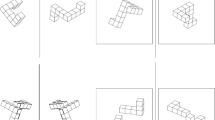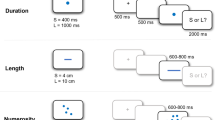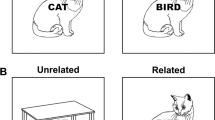Abstract
Several studies have shown that space immediately surrounding the body, or the peripersonal space is represented differently in the brain from the more distant extra-personal space. Moreover, the boundary of peripersonal space can be extended to space surrounding the tip of a tool held by the hand. However, it is not known if tools need to be connected to the body to modulate the peripersonal space. We used a line bisection task to investigate whether peripersonal space representation surrounds a virtual hand avatar that is disconnected from the body. Healthy participants conducted a line bisection task by responding with either a virtual hand avatar or a laser pointer. The to-be-bisected lines were presented either in peripersonal or extra-personal space. When the lines were placed in extra-personal space, the virtual hand avatar was presented near the line such that the hand avatar was far from participants and disconnected from their bodies. Results indicated a shift in the line bisection bias from the left to the right as the line presentation distance increased when using the laser pointer, whereas no shift in bias was observed when using the virtual hand avatar. This result indicates that objects resembling human hands presented even at a distance and disconnected from the body can be integrated into the peripersonal space, which suggests that peripersonal space representation is more flexible than previously reported.



Similar content being viewed by others
Data availability
All relevant data to generate figures in our experiment are shown in the Supporting information file.
References
Amemiya T, Ikei Y, Kitazaki M (2019) Remapping peripersonal space by using foot-sole vibrations without any body movement. Psychol Sci 30(10):1522–1532. https://doi.org/10.1177/0956797619869337
Bassolino M, Serino A, Ubaldi S, Làdavas E (2010) Everyday use of the computer mouse extends peripersonal space representation. Neuropsychologia 48(3):803–811. https://doi.org/10.1016/j.neuropsychologia.2009.11.009
Berti A, Frassinetti F (2000) When far becomes near: Remapping of space by tool use. J Cognit Neurosci 12(3):415–420. https://doi.org/10.1162/089892900562237
Blanke O, Slater M, Serino A (2015) Behavioral, neural, and computational principles of bodily self-consciousness. Neuron 88(1):145–166. https://doi.org/10.1016/j.neuron.2015.09.029
D’Angelo M, di Pellegrino G, Seriani S, Gallina P, Frassinetti F (2018) The sense of agency shapes body schema and peripersonal space. Scie Rep 8(1):1–11. https://doi.org/10.1038/s41598-018-32238-z
Farnè A, Iriki A, Làdavas E (2005) Shaping multisensory action-space with tools: Evidence from patients with cross-modal extinction. Neuropsychologia 43(2 SPEC. ISS.):238–248. https://doi.org/10.1016/j.neuropsychologia.2004.11.010
Gallivan JP, Adam McLean D, Valyear KF, Culham JC (2013) Decoding the neural mechanisms of human tool use. ELife 2013(2):1–29. https://doi.org/10.7554/eLife.00425
Gamberini L, Seraglia B, Priftis K (2008) Processing of peripersonal and extrapersonal space using tools: evidence from visual line bisection in real and virtual environments. Neuropsychologia 46:1298–1304. https://doi.org/10.1016/j.neuropsychologia.2007.12.016
Halligan PW, Marshall JC (1991) Left neglect for near but not far space in man. Nature 350(6318):498–500. https://doi.org/10.1038/350498a0
Holmes NP (2012) Does tool use extend peripersonal space? A review and re-analysis. Exp Brain Res 218(2):273–282. https://doi.org/10.1007/s00221-012-3042-7
Iriki A, Tanaka M, Iwamura Y (1996) Coding of modified body schema during tool use by macaque postcentral neurones. NeuroReport 7:2325–2330. https://doi.org/10.1097/00001756-199610020-00010
Jewell G, McCourt ME (2000) Pseudoneglect: a review and meta-analysis of performance factors in line bisection tasks. Neuropsychologia 38(1):93–110. https://doi.org/10.1016/S0028-3932(99)00045-7
Lloyd DM (2007) Spatial limits on referred touch to an alien limb may reflect boundaries of visuo-tactile peripersonal space surrounding the hand. Brain Cogn 64(1):104–109. https://doi.org/10.1016/j.bandc.2006.09.013
Longo MR, Lourenco SF (2006) On the nature of near space: effects of tool use and the transition to far space. Neuropsychologia 44(6):977–981. https://doi.org/10.1016/j.neuropsychologia.2005.09.003
Makin TR, Holmes NP, Zohary E (2007) Is that near my hand? Multisensory representation of peripersonal space in human intraparietal sulcus. J Neurosci 27(4):731–740. https://doi.org/10.1523/JNEUROSCI.3653-06.2007
Mangalam M, Cutts SA, Fragaszy DM (2019) Sense of ownership and not the sense of agency is spatially bounded within the space reachable with the unaugmented hand. Exp Brain Res 237(11):2911–2924. https://doi.org/10.1007/s00221-019-05645-5
Maravita A, Iriki A (2004) Tools for the body (schema). Trends Cognit Sci 8(2):79–86. https://doi.org/10.1016/j.tics.2003.12.008
McCourt ME, Garlinghouse M (2000) Asymmetries of visuospatial attention are modulated by viewing distance and visual field elevation: pseudoneglect in peripersonal and extrapersonal space. Cortex 36(5):715–731. https://doi.org/10.1016/S0010-9452(08)70548-3
Noel JP, Grivaz P, Marmaroli P, Lissek H, Blanke O, Serino A (2015) Full body action remapping of peripersonal space: the case of walking. Neuropsychologia 70:375–384. https://doi.org/10.1016/j.neuropsychologia.2014.08.030
Noel JP, Pfeiffer C, Blanke O, Serino A (2015) Peripersonal space as the space of the bodily self. Cognition 144:49–57. https://doi.org/10.1016/j.cognition.2015.07.012
Reed CL, Betz R, Garza JP, Roberts RJJ (2010) Grab it! Biased attention in functional hand and tool space. Atten Percept Psychophys 72(1):236–245. https://doi.org/10.3758/APP.72.1.236
Rizzolatti G, Fadiga L, Fogassi L, Gallese V (1997) The space around us. Science 277(5323):190–191. https://doi.org/10.1126/science.277.5323.190
Seraglia B, Priftis K, Cutini S, Gamberini L (2012) How tool use and arm position affect peripersonal space representation. Cogn Process 13(1 SUPPL):325–328. https://doi.org/10.1007/s10339-012-0458-8
Serino A, Bassolino M, Farnè A, Làdavas E (2007) Extended multisensory space in blind cane users. Psychol Sci 18(7):642–648. https://doi.org/10.1111/j.1467-9280.2007.01952.x
Serino A, Canzoneri E, Avenanti A (2011) Fronto-parietal areas necessary for a multisensory representation of peripersonal space in humans: an rTMS study. J Cognit Neurosci 23(10):2956–2967. https://doi.org/10.1162/jocn_a_00006
Serino A, Canzoneri E, Marzolla M, di Pellegrino G, Magosso E (2015) Extending peripersonal space representation without tool-use: evidence from a combined behavioral-computational approach. Front Behav Neurosci 9:1–14. https://doi.org/10.3389/fnbeh.2015.00004 (FEB)
Spence C, Paveni F, Driver J (2000) Crossmodal links between vision and touch in covert endogenous spatial attention. J Exp Psychol Hum Percept Perform 26(4):1298–1319
Spence C, Pavani F, Driver J (2004) Spatial constraints on visual-tactile cross-modal distractor congruency effects. Cognit Affect Behav Neurosci 4(2):148–169. https://doi.org/10.3758/CABN.4.2.148
Varnava A, McCarthy M, Beaumont JG (2002) Line bisection in normal adults: direction of attentional bias for near and far space. Neuropsychologia 40(8):1372–1378. https://doi.org/10.1016/S0028-3932(01)00204-4
Zampini M, Torresan D, Spence C, Murray MM (2007) Auditory-somatosensory multisensory interactions in front and rear space. Neuropsychologia 45(8):1869–1877. https://doi.org/10.1016/j.neuropsychologia.2006.12.004
Funding
This work was supported by Japan Society for the Promotion of Science [Grant numbers: 19H01490] to KY. The funders had no role in study design, data collection, and analysis, decision to publish, or preparation of the manuscript.
Author information
Authors and Affiliations
Contributions
Conceived and designed the experiment: DM KY. Performed the experiment: DM. Analyzed the data: DM. Wrote the paper: DM KY.
Corresponding author
Ethics declarations
Conflicts of interest
There are no conflicts of interest to declare.
Ethics approval
The ethical committee of the Department of Psychology at the University of Tokyo approved the experiment. The study was conducted according to the principles and guidelines of the Declaration of Helsinki.
Consent to participate
Informed consent was obtained from all individual participants included in the study.
Consent to publish
Informed consent was obtained from all individual participants to publish their data.
Additional information
Communicated by Francesca Frassinetti.
Publisher's Note
Springer Nature remains neutral with regard to jurisdictional claims in published maps and institutional affiliations.
Electronic supplementary material
Below is the link to the electronic supplementary material.
Rights and permissions
About this article
Cite this article
Mine, D., Yokosawa, K. Disconnected hand avatar can be integrated into the peripersonal space. Exp Brain Res 239, 237–244 (2021). https://doi.org/10.1007/s00221-020-05971-z
Received:
Accepted:
Published:
Issue Date:
DOI: https://doi.org/10.1007/s00221-020-05971-z




